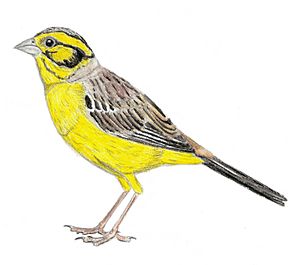Long-legged bunting facts for kids
Quick facts for kids Long-legged buntingTemporal range: Late Pleistocene-Holocene
|
|
|---|---|
 |
|
| Hypothetical restoration based on known material and related species | |
| Scientific classification |
The long-legged bunting (Emberiza alcoveri) was a type of bunting that is now extinct. It was special because it couldn't fly and had long legs and short wings. This bird lived on Tenerife, one of the Canary Islands. It is one of the very few passerine birds (which are usually small, perching birds) known to have lost the ability to fly. All of these flightless passerines are now extinct.
Contents
About the Long-Legged Bunting

Scientists group living things based on their features. This helps us understand how they are related. The long-legged bunting belongs to a group of birds called Emberiza. Its closest relatives are birds like Cabanis's bunting and the yellowhammer.
The Emberiza group is part of the bunting family, Emberizidae. These are small birds that mostly eat seeds. They have special beaks that help them do this. The long-legged bunting's scientific name, alcoveri, was chosen to honor a scientist named J. A. Alcover. He helped us learn a lot about old animal fossils.
What Did It Look Like?
Scientists found parts of the long-legged bunting's skeleton. These bones helped them learn about the bird. The main skeleton found is called the holotype. Seven other skeletons were also found. These bones are kept at the University of La Laguna in Tenerife, Spain.
This bunting was bigger than other Emberiza species that live today. It had longer legs and shorter wings. Its bill was also shaped differently. These features tell us that the long-legged bunting probably spent most of its time on the ground. It likely could not fly.
This makes it one of the rare passerine birds that couldn't fly. Other examples include four types of New Zealand wrens, such as Lyall's wren. All of these wrens are also extinct.
Like other buntings, the long-legged bunting was probably an omnivore. This means it ate both plants and animals. It likely ate seeds and small creatures like invertebrates (bugs). Because its bill was shaped differently, it might have been able to eat harder seeds too.
Where Did It Live?
The long-legged bunting was native to the Canary Islands. Scientists have only found its bones in a volcanic cave called Cueva del Viento. This cave is on the island of Tenerife.
Other animals that lived alongside this bunting included different birds, mammals, and lizards. The long-legged bunting likely lived in areas with laurel forests or transition forests. These places would have had plenty of food. The thick plants on the ground would have also protected it from predators flying above.
Why Did It Disappear?
The long-legged bunting lived on Tenerife for a very long time. It was there during the Upper Pleistocene and Holocene periods.
Humans arrived on the Canary Islands over 2,000 years ago. They brought new animals with them. These included invasive species like goats, pigs, cats, and sheep. These new animals might have hunted the buntings. They also changed the bird's home by eating plants or digging up the ground.
When Europeans arrived in the 1400s, they had an even bigger impact. They brought rats, which could have eaten the birds' eggs or young. They also cleared many forests to make space for farms.
The long-legged bunting likely became extinct because of these new animals and the destruction of its natural home.
See also
 In Spanish: Escribano patilargo para niños
In Spanish: Escribano patilargo para niños

